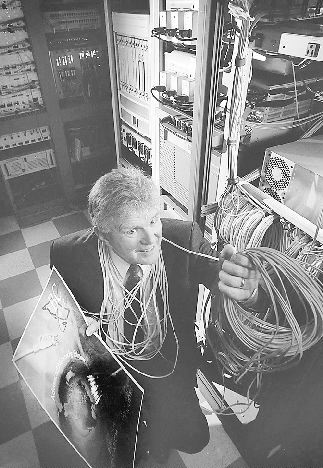Network connecting universities has capacity of five GB per second
Chad Skelton
Sun

Michael Hrybyk is the CEO of BCNet, which has quadrupled the network’s capacity to 50,000 times faster than a home high-speed Internet connection. Photograph by : Mark van Manen, Vancouver Sun
B.C.’s universities unveiled a new computer network Monday that redefines the meaning of high-speed Internet, with enough bandwidth to download an entire feature-length film in a single second.
The non-profit network, known as BCNet, connects the province’s major research universities to each other and to the wider world, so they can collaborate and share research data.
Until recently, the network had a capacity of about 1.25 gigabytes per second (GB/s) — fast, but insufficient for some of the major research projects in the province.
Michael Hrybyk, chief executive officer of BCNet, said a $6-million upgrade of the system — paid for by the provincial and federal governments — has quadrupled the network’s capacity to 5 GB/s, or about 50,000 times faster than your high-speed home connection.
What makes the network possible, said Hrybyk, is fibre-optic cable connecting B.C.’s major universities.
Two fibre cables, each no bigger than a strand of hair, can transmit data on up to 72 different wavelengths at once.
Each wavelength — essentially a different colour of light — is able to send up to 1.25 GB of data a second.
At the moment, said Hrybyk, BCNet has turned on just four of those wavelengths.
But, with a little extra equipment, it could turn on all 72, giving the network a bandwidth of 90 GB/s — or enough to download an entire movie library in mere seconds.
“We definitely have a world-class infrastructure network here for our leading researchers,” said Hrybyk.
The new network will be used to share large volumes of data from major research projects, such as the University of Victoria‘s Neptune underwater observatory.
Hrybyk said he also hopes the network will allow more distance learning and collaboration, by allowing students and teachers to do live videoconferencing in crystal-clear high definition.
“It won’t just be a fuzzy image,” he said. “You’ll get a real sense of what the instructor is doing and be able to see the students.”
Hrybyk said it will be some time before consumers have access to Internet speeds like this.
That’s because the wires that go into most people’s homes — copper phone lines and coaxial cables — simply don’t have the capacity of fibre-optic cable.
“The current infrastructure we have serving our homes and businesses is really inadequate for these next-generation, data-intensive types of things we’re doing,” he said.
(To learn more about scientific discoveries in B.C., check out The Vancouver Sun’s Science in B.C. blog at www.vancouversun.com/scienceinbc/)

